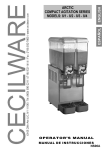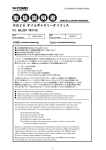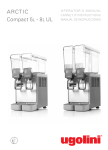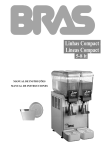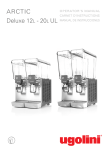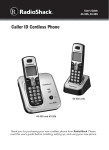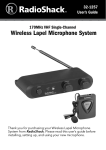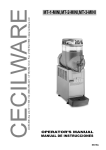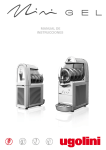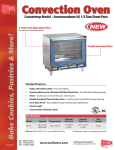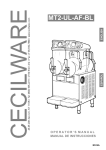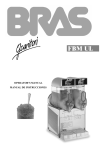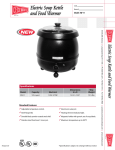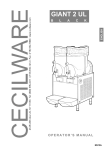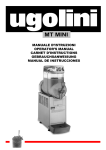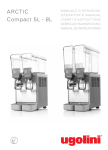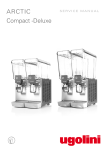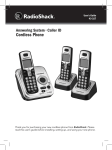Download ARCTIC DELUXE SERIES
Transcript
ENGLISH ARCTIC DELUXE SERIES ESPAÑOL ENGLISH 20/1PD - 20/2PD - 20/3PD - 20/4PD OPERATOR’S MANUAL MANUAL DE INSTRUCCIONES NS05A ARCTIC DELUXE SERIES 1 TECHNICAL CHARACTERISTICS damage is found, call the delivering carrier immediately to file a claim. 3 Install the unit on a counter top that will support the combined weight of dispenser and product bearing in mind what is stated in the preceding point 1 IMPORTANT warning. 4 A minimum of 15 cm (6”) of free air space all around the unit should be allowed to guarantee adequate ventilation. 5 Ensure that the legs are screwed tightly into the base of the machine. Replace the standard legs originally installed with the 100 mm (4”) legs whenever they are provided with the unit. 6 Before plugging the unit in, check if the voltage is the same as that indicated on the data plate. Plug the unit into a grounded, protected single phase electrical supply according to the applicable electrical codes and the specifications of your machine. Should you prefer to connect the unit directly to the mains, connect the supply cord to a 2-pole wall breaker, whose contact opening is at least 3mm (0.125”). Do not use extension cords. 20/1PD 20/2PD 20/3PD 20/4PD Transparent removable bowls 1 2 3 4 Gal Gal 5.4 3.17 5.4 3.17 5.4 3.17 5.4 3.17 width inches 7.125 14.5 21.25 28.5 depth inches 18.5 18.5 18.5 18.5 5.4Gal 3.17Gal inches 26.5 24 26.5 24 26.5 24 26.5 24 Net weight, approx. 5.4Gal 3.17Gal Lbs 48.5 44 70.5 60 92.5 121.25 79.5 97 Gross weight, approx. 5.4Gal 3.17Gal Lbs 55 48.5 80 61.75 102 88.25 130 108 1 2 3 4 Capacity approx. of each n bowl, Standard Optional Dimensions: height Adjustable thermostats n Hermetic compressor Air-cooled condenser Overload protector Noise level lower than 70 dB (A) ATTENTION Failure to provide proper electrical ground according to applicable electrical codes could result in serious shock hazard. IMPORTANT Read electrical ratings written on the data plate of the individual units; the data plate is adhered on the dispensing side panel of the unit, just behind the drip tray (the right side drip tray in multiple bowl models). The serial number of the unit (preceded by the symbol #) is adhered just below the right bowl. Data plate specifications will always supersede the information in this manual. 7 The unit doesn’t come presanitized from the factory. Before serving products, the dispenser must be disassembled, cleaned and sanitized according to this handbook instructions (chapter 5.3 CLEANING AND SANITAZING PROCEDURES). Specifications are subject to change without notice. IMPORTANT 2 INTRODUCTION Install the dispenser so that the plug is easily accessible. Please read all sections of this manual thoroughly to familiarize yourself with all aspects of the unit. Like all mechanical products, this machine will require cleaning and maintenance. Besides, dispenser working can be compromised by operator’s mistakes during disassembly and cleaning. It is strongly recommended that personnel responsible for the equipment’s daily operations, disassembly, cleaning, sanitizing and assembly, go through these procedures in order to be properly trained and to make sure that no misunderstandings exist. 4 TO OPERATE SAFELY 1 Do not operate the dispenser without reading this operator’s manual. 2 Do not operate the dispenser unless it is properly grounded. 3 Do not use extension cords to connect the dispenser. 4 Do not operate the dispenser unless all panels are restrained with screws. 5 Do not obstruct air intake and discharge openings: 15 cm (6”) minimum air space all around the dispenser. 6 Do not put objects or fingers in panels louvers and faucet outlet. 7 Do not remove bowls, augers and panels for cleaning or routine maintenance unless the dispenser is disconnected from its power source. 3 INSTALLATION 1 Remove the corrugate container and packing materials and keep them for possible future use. IMPORTANT ATTENTION When handling the machine never grasp it by the bowls or by the evaporator cylinders. The manufacturer refuses all responsibilities for possible damages which may occur through incorrect handling. In case of damages, the power cord must be replaced by qualified personnel only in order to prevent any shock hazard. 8 This unit is not meant to be used outside. 2 Inspect the uncrated unit for any possible damage. If 2 5. 2 OPERATION HELPFUL HINTS 9 This unit is not to be installed in areas subject to waterspouts.. 10 Do not use water-jets to clean the unit. 11 This unit can work in a room temperature range between +5° and +32°C (41F and 90F). 1 The length of time for cooling down the product is governed by many variables, such as ambient temperature and beverage initial temperature. 2 To shorten product cooling down time and increase productivity, it is advisable to pre-chill the product to be used in the dispenser. 3 To shorten product cooling down time and increase productivity, the bowl should be refilled after the product level drops lower than half and at the start of each day. 4 The dispenser must be able to emit heat. In case it seems excessive, check that no heating source is close to the unit and air flow through the slotted panels is not obstructed by wall or boxes. Allow at least 15 cm (6”) of free clearance all around the dispenser. In any case if the product in the bowls is cold the unit is running properly. 5 How to reset beverage temperature:to reset beverage temperature please apply to a technician. The proper temperature is preset at the factory. 5 OPERATING PROCEDURES 1 Clean and sanitize the unit according to the instructions in this manual. See chapter 5.3 CLEANING AND SANITIZING PROCEDURES. 2 Fill the bowls with product to the maximum level mark. Do not overfill. The exact quantity of product (expressed as liters and gallons) is shown by marks on the bowl. 3 In case of products to be diluted with water, potable water, pour water into bowl first, then add correct quantity of product. In case of natural squashes, it is advisable to strain them, in order to prevent pulps from obstructing the faucet outlet. 4 Install the covers and check that they are correctly placed over the bowls. 5 Set the control switches as shown in chapter 5.1 DESCRIPTION OF CONTROLS. 6 The dispenser must always run with the covers installed to prevent a possible contamination of the product. 7 Always leave the dispenser on, as the refrigeration stops automatically when the beverage reaches the dispensing temperature. The mixing devices will continue to turn. 8 To maintain a high standard of flavour, keep refrigeration and mixing devices on during the night when beverage is in the bowl. 5. 3 CLEANING AND SANITIZING PROCEDURES Cleaning and sanitizing of the dispenser are recommended to guarantee the conservation of the best product taste and the highest unit efficiency. This section is a procedural guideline only and is subject to the requirements of the local Health Authorities. Prior to the disassembly and cleaning, the machine must be emptied of product. 5. 3. 1 DISASSEMBLY IMPORTANT Operate the dispenser with food products only. 5. 1 DESCRIPTION OF CONTROLS ATTENTION Before any disassembly and/or cleaning procedure make sure that the dispenser is disconnected from its power source by unplugging it or switching off the 2-pole wall breaker. The dispenser is equipped with a power switch and each bowl is operated by a mixing device switch. Their functions are as follows: Power switch 0 position : Power is turned OFF to all functions. I position This position operates the fan motor and makes the mixing : devices suitable to be turned on by relevant switches. 1 Remove cover from the bowl. 2 Remove the empty bowl by lifting first its front side (faucet side) up and off bowl gasket (see figure 1). Mixing device switch 0 position : OFF. I position : Mixing device runs. figure 1 To operate the dispenser 3 Remove the bowl gasket. 4 Remove the pump impeller from its location. 5 Gravity faucet: extract the piston and then remove the 1 Set power switch to I position. 2 Set mixing device switch(es) to I position. 3 ARCTIC DELUXE SERIES 4 In the same manner clean the evaporator cylinder(s) using a soft bristle brush. 5 Rinse all cleaned parts with cool clean water. dispensing handle (see figure 2). 5. 3. 3 SANITIZING Sanitizing should be performed immediately prior to starting the machine. Do not allow the unit to sit for extended periods of time after sanitization. 1 Wash hands with a suitable antibacterial soap. 2 Prepare at least two gallons of a warm (45-60 °C 120140 °F) sanitizing solution (100 PPM available chlorine concentration or 1 spoon of sodium hypoclorite diluted with two litres, 0.5 gallons of water) according to your local Health Codes and manufacturer’s specifications. 3 Place the parts in the sanitizing solution for five minutes. 4 Do not immerse the lighted top covers in liquid. Carefully wash their undersides with the sanitizing solution. 5 Place the sanitized parts on a clean dry surface to air dry. 6 Wipe clean all exterior surfaces of the unit. Do not use abrasive cleaner. figure 2 6 Slide drip tray out and empty it. 5. 3. 2 CLEANING 5. 3. 4 ASSEMBLY 1 Slide the drip tray into place. 2 Gravity faucet: install the faucet handle and the piston with its gasket (see figure 3). IMPORTANT Do not attempt to wash any machine components in a dishwasher. ATTENTION Before any disassembly and/or cleaning procedure make sure that the dispenser is disconnected from its power source. 1 Prepare at least two gallons of a mild cleaning solution of warm (45-60 °C 120-140 °F) potable water and dishwashing detergent. Do not use abrasive detergent. Important: if present, follow label directions, as too strong a solution can cause parts damage, while too mild a solution will not provide adequate cleaning. figure 3 3 Fit the bowl gasket to the evaporator. Note: the largest brim of the gasket must face against the drip plate (see figure 4). IMPORTANT In order to prevent any damage to the dispenser use only a detergent suitable with plastic parts. 2 Using a brush, suitable for the purpose, thoroughly clean all disassembled parts in the cleaning solution. ATTENTION When cleaning the machine, do not allow excessive amounts of water around the electrically operated components of the unit. Electrical shock or damage to the machine may result. figure 4 4 Place bowl on the unit. Wet the gasket for ease of insertion. Please take care that the hook on the backside of the bowl be inserted properly in its seat on the upper drip plate. (see figure 3 Do not immerse the lighted top covers in liquid. Wash them apart with the cleaning solution. Carefully clean their undersides. 4 5). figure 5 5 Use fresh product to chase any remaining sanitizer from the bowl(s). Drain this solution. Do not rinse out the machine. 5. 4 IN-PLACE SANITIZATION Daily: The In-Place Sanitization prior to starting the machine may be performed, if needed, only as further precaution, in addition to the Disassembled Parts Sanitization described before, but never in lieu of it. 1 Prepare two gallons of a warm (45-60°C, 120-140 °F) sanitizing solution (100 PPM available chlorine concentration or 1 spoon of sodium hypoclorite diluted with two litres, 0.5 gallons of water) according to your local Health Codes and manufacturer’s specifications. 2 Pour the solution into the bowl(s). 3 Using a brush suitable for the purpose, wipe the solution on all surfaces protruding above the solution-level and on the underside of the top cover(s). 4 Install the top cover(s) and operate the unit. Allow the solution to agitate for about two minutes. Drain the solution out of the bowl(s). 5 Use fresh product to chase any remaining sanitizer from the bowl(s). Drain this solution. Do not rinse out the machine. 6 ROUTINE MAINTENANCE Daily: inspect the machine for signs of product leaks past seals and gaskets. If proper assembly does not stop leaks around seals or gaskets, check for improper lubrication, worn or damaged parts. Replace parts as needed with original spare parts from the supplier. 6. 1 MAINTENANCE (TO BE CARRIED OUT BY QUALIFIED SERVICE PERSONNEL ONLY) Monthly: clean all internal components, primarily the condenser, using compressed air. To clean these internal parts, unplug the unit or switch off the 2pole wall breaker, then remove front panel (dispensing side). Condenser fins are very sharp. Use extreme caution when cleaning. 5 ARCTIC DELUXE SERIES 2 Controlar que el distribuidor no haya sufrido daños durante el transporte. De haberlos sufrido, reclamar inmediatamente al transportista. 3 Colocar el distribuidor en un mostrador en grado de sostener su peso incluso con la carga completa, teniendo en cuenta cuanto indicado en IMPORTANTE, del punto 1. 4 Dejar un espacio libre de por lo menos 15 cm (6”) alrededor del aparato para no impedir el flujo de aire de refrigeración. 5 Controlar la estabilidad del aparato, regulando la altura de los pies. 6 Grifo en acero inox por gravedad. Montar el grifo, teniendo en cuenta cuanto indicado en 5.3.4. REMONTAJE. 7 Antes de enchufar el aparato con la toma de corriente controlar que la tensión de la red sea aquella indicada en la placa. Enchufar el distribuidor a una red monofásica, sirviéndose de una toma completa de tierra, según lo previsto por la normativa vigente. En el supuesto de realizar una conexión fija a la red, conectar el cable a un interruptor de pared de tipo bipolar con apertura de contactos de 3 mm (0.125”) por lo menos. No utilizar cordones conectores para enchufar el aparato al suministro de corriente eléctrica. 1 CARACTERISTICAS TECNICAS 20/1PD 20/2PD 20/3PD 20/4PD Contenedores transparentes desmontables 1 2 3 4 Gal Gal 5.4 3.17 5.4 3.17 5.4 3.17 5.4 3.17 ancho inches 7.125 14.5 21.25 28.5 largo inches 18.5 18.5 18.5 18.5 5.4Gal 3.17Gal inches 26.5 24 26.5 24 26.5 24 26.5 24 Peso neto, aproximado 5.4Gal 3.17Gal Lbs 48.5 44 70.5 60 92.5 121.25 79.5 97 Peso bruto, aproximado 5.4Gal 3.17Gal Lbs 55 48.5 80 61.75 102 88.25 130 108 1 2 3 4 Capacidad de cada contenedor, aproximada n Standard Optional Dimensiones: alto Termostatos regulables n Motocompresor hermético Condensador a ventilación forzada Guardamotor Nivel de ruido inferior a 70dB (A) ATTENCION IMPORTANTE Cerciorarse que el aparato esté correctamente conectado a tierra; en caso contrario es posible causar shock eléctricos a las personas o dañar el distribuidor. Características eléctricas: leer los datos detallados en la placa del distribuidor; ésta se encuentra en la parte inferior del panel frontal, detrás del cajón recoge-gotas de la derecha. Los números de matrícula de los aparatos (precedidos por el símbolo#) están colocados dentro del alojamiento portatinterruptores de izquierda. Los datos detallados sobre la placa son aquellos a los que se debe siempre hacer referencia. 8 El distribuidor no sale de fábrica prelavado e higienizado. Antes de utilizarlo debe ser desarmado, lavado e higienizado siguiendo cuanto dicho en las presentes instrucciones del capítulo 5.3 LIMPIEZA. Se reserva el derecho de efectuar modificaciones sin previo aviso. 4 PARA UN FUNCIONAMIENTO SEGURO 2 INTRODUCCION 1 No utilizar el distribuidor antes de haber leído el presente manual de instrucciones. 2 No utilizar el distribuidor si no está correctamente conectado a tierra. 3 No utilizar cordones conectores para enchufar el distribuidor al suministro de corriente. 4 No poner en funcionamiento el distribuidor si los paneles no se encuentran en su lugar y fijados con los tornillos. 5 No impedir el flujo de aire de refrigeración, dejar un espacio libre de por lo menos 15 cm alrededor del distribuidor. 6 No introducir los dedos u objetos en las ranuras de los paneles y en la apertura del grifo. 7 No desmontar el contenedor, no quitar los mezcladores o paneles para limpieza o manutención sin cerciorarse que el distribuidor esté desenchufado del suministro de corriente. Les aconsejamos que lean atentamente este manual de instrucciones para conocer todas las características del distribuidor. También este distribuidor, como todos los productos mecánicos, necesita de limpieza y cuidado. Se corre el riesgo de impedir su buen funcionamiento si se verificasen errores cometidos por el usuario durante la fase de desmontaje y limpieza. Por dicho motivo es importante que los procedimientos de desmontaje, lavado, higienización y limpieza, siendo operaciones cotidianas, sean conocidas sin posibilidad de error por todo el personal responsable del distribuidor. 3 INSTALACION 1 Quitar el distribuidor del embalaje: guardar este último por si hubiera cualquier eventualidad. ATTENCION Si el cable de alimentación está dañado, debe ser substituito por el fabricante o desde su servicio de asistencia técnica o, en cualquier caso, por una persona cualificada con el fin de evitar cualquier tipo de riesgo. IMPORTANTE En la operación de transporte o levantamiento no se debe coger nunca el distribuidor por sus contenedores transparentes o por los cilindros evaporadores. El fabricante no responde de los daños acarreados por estas maniobras equivocadas. 8 Aparato no apto para uso exterior. 9 Aparato no apto en instalaciones donde haya cercano fuentes de agua . 10 Para la limpieza no utilizar chorros de agua. 6 11 Para el correcto funcionamiento, coma la temperatura ambiente debe estar comprendida ientre 5°C y 32°C (14F y 90F). Para el funcionamiento del distribuidor: 1 Colocar el interruptor general en posición I. 2 Colocar el interruptor agitación en posición I. 5 INSTRUCCIONES DE EMPLEO 5. 2 SUGERENCIAS 1 Lavar e higienizar el distribuidor antes de utilizarlo siguiendo cuanto se ha dicho en las presentes instrucciones en el capítulo 5.3 LIMPIEZA. 2 Llenar los contenedores con el producto deseado hasta que alcance el nivel máximo indicado (no superar dicho nivel). La cantidad de producto presente en el contenedor (en litros o en galones) está indicada con señales específicas situadas en el contenedor mismo. 3 Si se quiere distribuir productos concentrados a diluirse con agua, verter en los contenedores el agua agregando a continuación la cantidad necesaria de producto concentrado, según las instrucciones del fabricante. Si se quieren emplear zumos naturales se recomienda filtrarlos para evitar que las partes sólidas puedan obstruir el pasaje del grifo. 4 Montar las tapas sobre los contenedores cerciorándose que queden bien colocadas. 5 Accionar los interruptores (ver capítulo 5.1 DESCRIPCIÓN DE LOS MANDOS). 6 El distribuidor debe funcionar siempre con las tapas montadas para prevenir una posible contaminación del producto. 7 El distribuidor debe funcionar ininterrumpidamente: el grupo frigorífico se parará automáticamente cuando el producto esté listo para ser distribuido. Los dispositivos mezcladores seguirán funcionando. 8 Para la buena conservación del producto, el distribuidor deberá funcionar también durante la noche. 1 El tiempo necesario para obtener la refrigeración del producto varía en función de distintos factores como por ejemplo la temperatura ambiente y la temperatura inicial del producto. 2 Llenando los contenedores con producto ya enfriado previamente se incrementa la eficiencia del distribuidor. 3 Para disminuir ulteriormente los tiempos de restablecimiento y, por lo tanto, aumentar la autonomía del distribuidor, volver a llenar cuando el nivel del producto desciende a mitad evaporador. 4 Todos los distribuidores de este tipo deben despedir calor. Si el calor producido fuera excesivo, controlar que ninguna fuente de calor se encuentre cerca del distribuidor y, en modo particular, cerca de las rejillas de los paneles. Cerciorarse además, que el flujo de aire no esté obstaculizado por paredes cercanas, cajas u otras cosas. Dejar por lo menos 15 cm (6”) de espacio libre alrededor del distribuidor. En todo caso cuando el producto dentro de los contenedores está frio, es señal de que todo funciona bien y que el calor producido no es alarmante. 5 Regulación de la temperatura: para este tipo de operación, dirigerse exclusivamente al técnico.La temperatura ideal de las bebidas ha sido establecida y regulada en la fábrica. 5. 3 La limpieza y el lavado son fundamentales para garantizar la perfecta conservación del gusto de la bebida y la máxima eficiencia de vuestro distribuidor. Los procedimientos descritos a continuación deben ser considerados de carácter general y pueden variar por efecto de la reglamentación de higiene vigente. Antes del desarmado para el lavado del distribuidor debe quitarse todo el producto. IMPORTANTE Utilizar el distribuidor solamente con productos alimenticios. 5. 1 LIMPIEZA DESCRIPCION DE LOS MANDOS 5. 3. 1 El distribuidor está provisto de un interruptor general y, para cada contenedor, de un interruptor para el mando del dispositivo de agitación. A continuación describimos la variedad de las funciones de los interruptores: DESMONTAJE ATTENCION Interruptor general Posición 0 : el distribuidor está apagado. Posición I el distribuidor está habilitado : para el funcionamiento. Ventilador en función. Antes de proceder con el desmontaje de cualquier componente, desenchufar de la toma de corriente eléctrica el enchufe del aparato o bien apagar el interruptor externo de pared. 1 Quitar la tapa del contenedor. 2 Quitar el contenedor vacío levantándolo por la parte anterior y desprendiendolo de la junta (ver figura 1). Interruptor agitación Posición 0 : dispositivo de agitación parado. Posición I : dispositivo de agitación en función. figura 1 7 ARCTIC DELUXE SERIES 3 Quitar la junta del contenedor. bebida. 4 Sacar la turbina pompa. ATTENCION 5 Grifo en acero inox por gravedad: Sacar el pisón y desmontar la palanca mando grifo (ver figura 2). Durante el lavado del distribuidor no usar mucha cantidad de agua cerca de los componentes eléctricos; en caso contrario es posible que se verifiquen shock eléctricos o también se dañe el distribuidor. 3 Enjuagar todas las partes con agua corriente 5. 3. 3 REMONTAJE 1 Colocar el cajón recoge-gotas en su alojamiento. 2 Grifo en acero inox por gravedad: montar la palanca figura 2 mando grifo y enfilar el pisón unido a la su junta (ver figura 3). 6 Sacar el cajón recoge-gotas y vaciarlo. 5. 3. 2 LAVADO IMPORTANTE No lavar ningún componente de la maquina en lavavajillas. figura 3 ATTENCION 3 Poner la junta al evaporador, de modo que el borde de Antes de efectuar cualquier tipo de limpieza, desenchufar de la toma de corriente eléctrica el enchufe del aparato o bien apagar el interruptor externo de pared. mayor ancho se quede en contacto con el plano recoge-gotas (ver figura 4). 1 Poner en una palangana aproximadamente ocho litros de agua caliente (45°-60°C) (120F-140F) y detergente apropiado respetando con atención las instrucciones del fabricante; una solución demasiado concentrada de detergente puede provocar daños en las partes a lavar, en vez una solución demasiado diluida puede no limpiar bastante. No utilizar detergentes abrasivos. figura 4 IMPORTANTE Para prevenir daños al distribuidor utilizar solamente un detergente compatible com las partes de plastico. 4 Poner el contenedor sobre el distribuidor. Por facilitar esta operación, mojar la junta con un poco de agua. 2 Emplear un cepillo apropiado y lavar minuciosamente con la solución detergente todas las partes en contacto con la Asegurarse que el gancio posterior del contenedor estè insertado en el lugar correcto del piano recoge-gotas. 8 (ver figura 5) de pared, a continuación desmontar el panel. Prestar atención a las aletas del condensador porque tienen filo. figura 5 5 Enjuagar con bebida fresca para eliminar todo residuo posible de solución para higienizar del fondo de los contenedores. Secar la parte interior de los contenedores con una servilleta de papel desechable. 5. 4 HIGIENIZACION DEL DISTRIBUIDOR MONTADO Cada día: La higienización del aparato montado, antes de ser puesto en funcionamiento, puede ser efectuada, si es necesario, solamente como una ulterior prevención adicional a la higienización del aparato desmontado descrito anteriormente, pero no debe sustituir jamás a la efectuada con el aparato desmontado. 1 Poner en una palangana una solución de agua o producto para higienizar aprobado por las autoridades de vuestro país, respetando las especificaciones del fabricante. Si se carece de un producto para higienizar específico, preparar una solución de agua e hipoclorito de sodio (lejía uso alimenticio) en la proporción de 1 cucharadita por cada 2 litros (0.5 gallons) de agua. 2 Verter la solución en los contenedores. 3 Usando un cepillo apropiado fregar con la solución todas las partes sobre el nivel de la solución y sobre la parte inferior de la tapa. 4 Colocar la tapa y poner en función el distribuidor de modo que permita a la solución agitarse 2 minutos. 5 Vaciar los contenedores de la solución para higienizar por medio de los grifos. 6 Enjuagar con bebida fresca para eliminar del fondo de los contenedores todo residuo posible de solución para higienizar. Secar la parte interior de los contenedores con una servilleta de papel desechable. 7 No efectuar más operaciones de enjuague. 6 MANUTENCION Cada día: controlar el distribuidor y que no se verifiquen pérdidas de producto de las juntas. Si se notasen pérdidas, controlar , antes de todo, que el distribuidor esté montado correctamente, luego que las juntas no necesiten lubricación y, por último, que dichas juntas no sean defectuosas o estén gastadas, si es así reemplazarlas con recambios originales del fabricante. 6. 1 MANUTENCION (SOLAMENTE POR EL SERVICIO POSTVENTA) Cada mes: eliminar el polvo que se acumula sobre el filtro del condensador. Antes de efectuar dicha operación desenchufar el distribuidor de la toma de corriente o bien apagar el interruptor 9 ARCTIC DELUXE SERIES SPARE PARTS LIST DESCRIPCION PIEZAS DE REPUESTO 46 47 48 49 50 10 2408_49 V 0.4 08A09 1 2 6 7 8 9 10 11 12 13 14 15 16 17 17 19 20 21 26 27 30 31 32 33 34 35 36 37 37A 38 38A 38B 39 40 41 42 43 44 45 46 47 48 49 50 00651 00651 00653 00655 00656 00112 00117 00116 00045 RRR 00652 00725 00657 00671 00654 00672 00077 00028 00659 00660 00006 00048 00237 00297 00265 >>> >>> 00313 00133 00045 00673 00298 00179 00158 RRR 00532 00564 00565 00004 00674 00675 33900-01011 00676 00678 00679 5.4gal It bowl cover 3.17gal bowl cover Bowl gasket Plastic I-beam for connection Central pivot Central pivot OR Motor magnet Motor bracket Motor Back panel 5.4gal bowl for pump Spray tube for 3.17gal bowl 12 l bowl for pump Fast agitation impeller (Blue) Gentle agitation impeller (Grey) Bent tube for 5.4gal bowl Faucet piston Faucet gasket Picture Push handle Switch Switch cap Side panel Terminal block cover Terminal block with cable clamp Overload protector Relay Fan for 3.17gal Fan for 5.4gal Fan motor for 3.17gal Fan motor for 5.4gal Fan motor for 1 bowl Clip Rubber leg Dispensing side panel Stainless steel fixing screw for panel Drip tray cover Drip tray Thermostat Central pivot Washer Impeller mixer motor Mixer motor Pump motor bracket Tapa contenedor 5.4gal Tapa contenedor 3.17gal Junta contenedor Perfil de union Pivote central OR del pivote central Embrague magnetico Placa soporte motor Motor Panel postsrior Contenedor 5.4gal para bomba Tubo de flujo para contenedor 3.17gal Contenedor 12 l para bomba Turbina bomba 60Hz Turbina bomba Tubo de flujo para contenedor 5.4gal Pistón del grifo Junta del grifo Fotografia Palanca de mando grifo Interruptor Protección interruptor Panel lateral Protección pasacable Pasacable Guardamotor Relé Aspas para 3.17gal Aspas para 5.4gal Motor ventilador por 3.17gal Motor ventilador por 5.4gal Motor ventilador por 1 behalter Clip Pie nivelador Panel lado grifo Tornillo inox fijacion paneles Rejilla cajón Cajón recoge-gotas Termostato Pivote central Arandela Turbina motor agitador Motor agitador Placa soporte motor bomba >>> RRR Please order what printed on piece See table Pedir com la identificación marcada en la pieza Ver tabla RRR 13 41 20/1PD 00306 00239 20/2PD 00717 00240 20/3PD 00723 00241 20/4PD 00724 00722 11 ARCTIC DELUXE SERIES WIRING DIAGRAM SCHEMA ELECTRIQUE ESQUEMA ELECTRICO 1 2-3-4-5 6-7-8-9 10-11-12-13 14 15 Switch Thermostat Pump/mixer switch Pump/mixer Fan Motor Compressor Interrupteur Thermostat Interrupteur pompe/brasseur Pompe/brasseur Moteur ventilateur Compresseur 12 Interruptor Termostato Interruptor bomba/agitador Bomba/agitador Ventilador Motocompresor NOTES- NOTAS: 13 ARCTIC DELUXE SERIES NOTES- NOTAS: 14 NOTES- NOTAS: 15 CECILWARE CORPORATION 43-05 20th Avenue Long Island City, N.Y. 11105 Tel. (800) 935 2211 Fax (718) 932 7860 Email : [email protected] www.cecilware.com 2408_49 V0.4 08A09
This document in other languages
- español: Cecilware 20/2PD

















